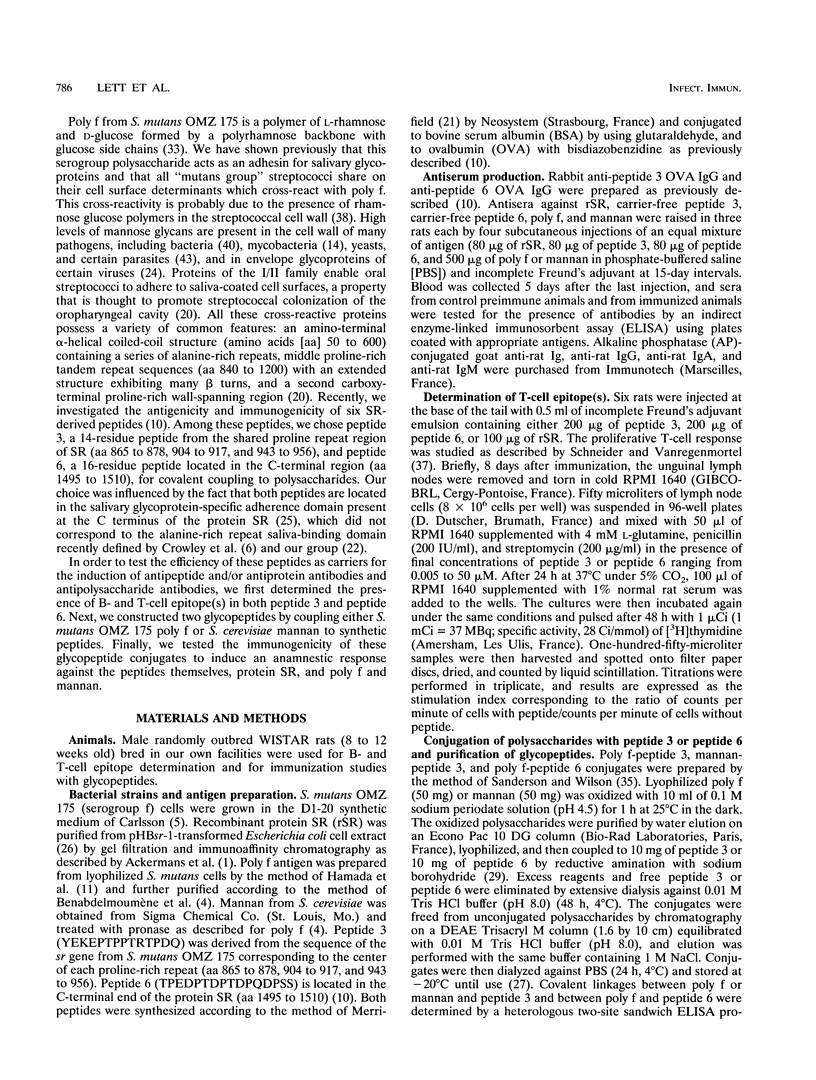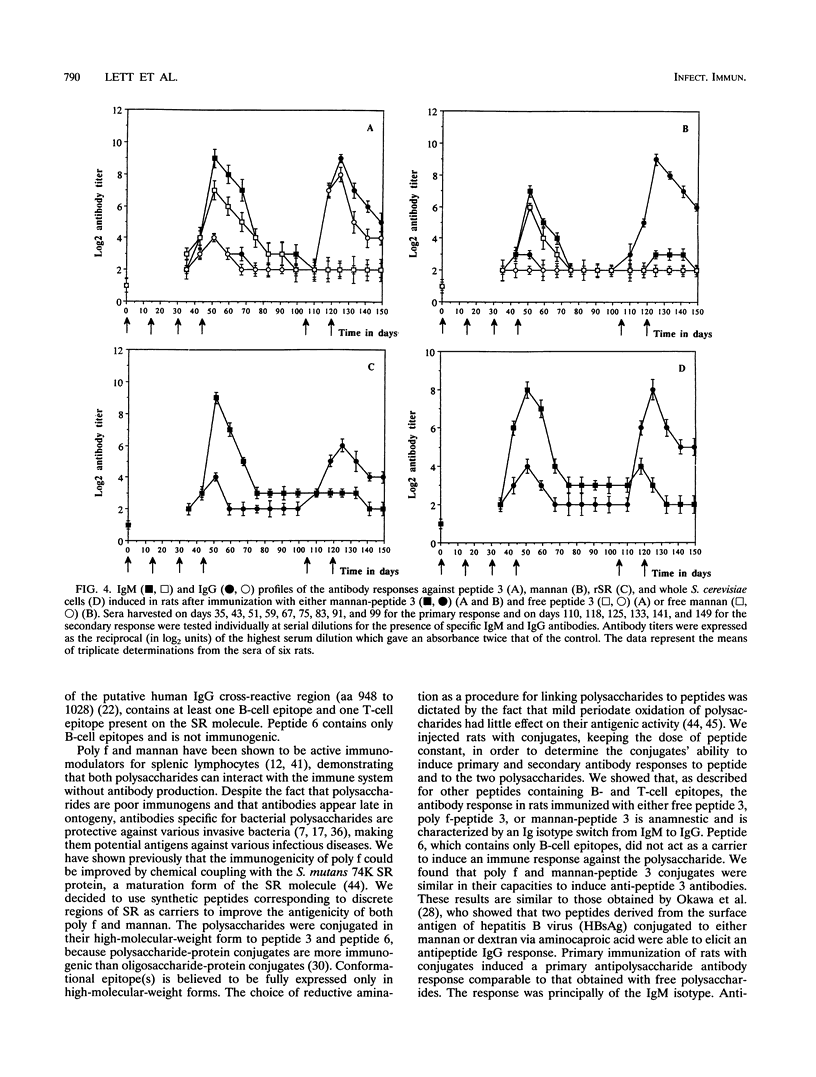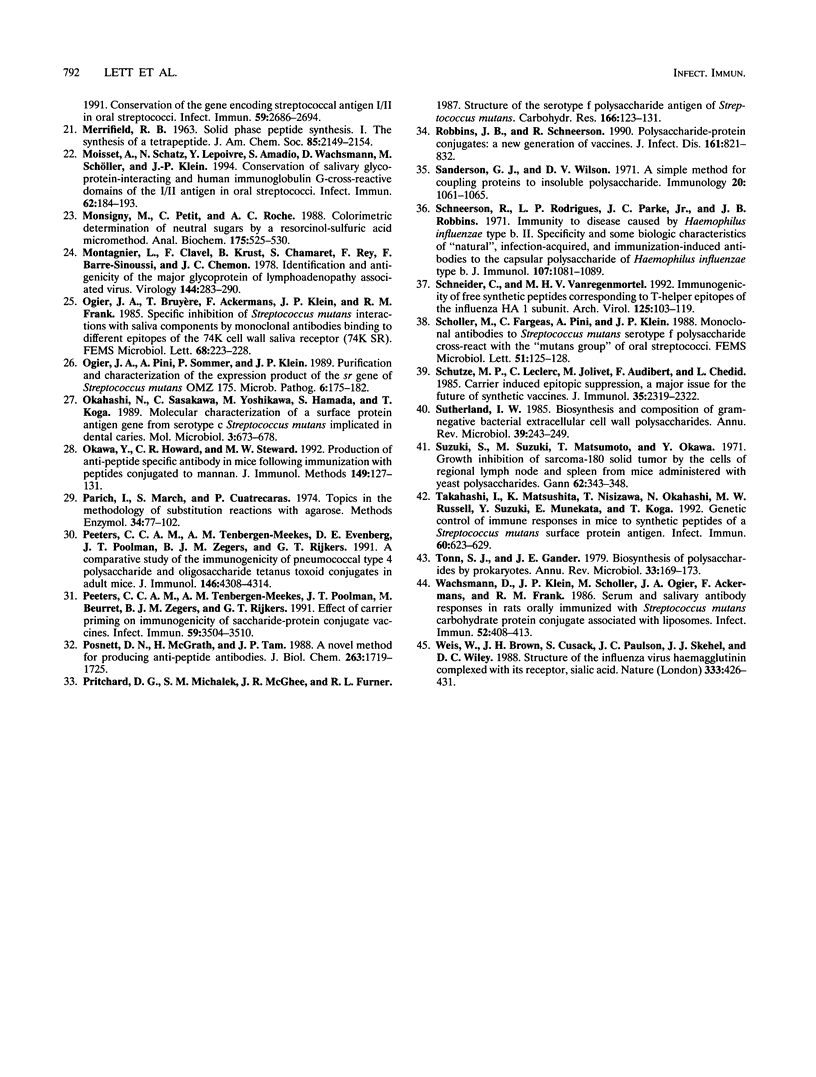Abstract
To develop a general model of polysaccharide-peptide vaccine, we have investigated the efficiency of linear peptides derived from protein SR, and adhesin of the I/II protein antigen family of oral streptococci, to act as carriers for two T cell-independent polysaccharides: serogroup f polysaccharide from Streptococcus mutans OMZ 175 (poly f) and Saccharomyces cerevisiae mannan. Peptide 3 (YEKEPTPPTRTPDQ) and peptide 6 (TPEDPTDPTDPQDPSS), accessible on the native SR protein as demonstrated by their reactivity in enzyme-linked immunosorbent assays with rat antisera raised against protein SR, correspond to immunodominant regions of SR. Peptide 3 contains at least one B- and one T-cell epitope, as demonstrated by its ability to induce peptide- and SR-specific antibody responses without any carrier and to stimulate the proliferation of rat lymph node cells primed either with free peptide or native SR, whereas peptide 6 contains only B-cell epitope(s). Peptide 3 was then covalently coupled though reductive amination to either poly f or mannan, and peptide 6 was coupled to poly f. Subcutaneous immunizations of rats with poly f-peptide 3 or mannan-peptide 3 conjugates produced a systemic immunoglobulin M (IgM) and IgG antibody response, and the elicited antibodies reacted with free poly f or mannan, peptide 3, protein SR, and S. mutans or S. cerevisiae whole cells. Rats immunized with poly f-peptide 6 did not develop any antipeptide or anti-SR response. Furthermore, a booster immunization of animals with poly f-peptide 3 or mannan-peptide 3 conjugates induced high titers of anti-peptide 3, anti-poly f, and antimannan antibodies, which occurred quickly. The response is anamnestic for the peptide and the polysaccharides and is characterized by an Ig switch from IgM to IgG. The data presented here confirm that the presence of B- and T-cell epitopes is necessary to induce an anamnestic antipeptide response and that a peptide containing relevant B- and T-cell epitopes can act as a good carrier in improving an antipolysaccharide anamnestic immune response.
Full text
PDF







Selected References
These references are in PubMed. This may not be the complete list of references from this article.
- Ackermans F., Pini A., Wachsmann D., Schöller M., Ogier J., Klein J. P. Anti-IgG antibodies in rheumatic diseases cross-react with Streptococcus mutans SR antigen. Clin Exp Immunol. 1991 Aug;85(2):265–269. doi: 10.1111/j.1365-2249.1991.tb05716.x. [DOI] [PMC free article] [PubMed] [Google Scholar]
- Arnon R., Horwitz R. J. Synthetic peptides as vaccines. Curr Opin Immunol. 1992 Aug;4(4):449–453. doi: 10.1016/s0952-7915(06)80037-3. [DOI] [PubMed] [Google Scholar]
- Benabdelmoumene S., Dumont S., Petit C., Poindron P., Wachsmann D., Klein J. P. Activation of human monocytes by Streptococcus mutans serotype f polysaccharide: immunoglobulin G Fc receptor expression and tumor necrosis factor and interleukin-1 production. Infect Immun. 1991 Sep;59(9):3261–3266. doi: 10.1128/iai.59.9.3261-3266.1991. [DOI] [PMC free article] [PubMed] [Google Scholar]
- Carlsson J. Nutritional requirements of Streptococcus sanguis. Arch Oral Biol. 1972 Sep;17(9):1327–1332. doi: 10.1016/0003-9969(72)90165-3. [DOI] [PubMed] [Google Scholar]
- Crowley P. J., Brady L. J., Piacentini D. A., Bleiweis A. S. Identification of a salivary agglutinin-binding domain within cell surface adhesin P1 of Streptococcus mutans. Infect Immun. 1993 Apr;61(4):1547–1552. doi: 10.1128/iai.61.4.1547-1552.1993. [DOI] [PMC free article] [PubMed] [Google Scholar]
- Egan M. L., Pritchard D. G., Dillon H. C., Jr, Gray B. M. Protection of mice from experimental infection with type III group B Streptococcus using monoclonal antibodies. J Exp Med. 1983 Sep 1;158(3):1006–1011. doi: 10.1084/jem.158.3.1006. [DOI] [PMC free article] [PubMed] [Google Scholar]
- Ezekowitz R. A., Kuhlman M., Groopman J. E., Byrn R. A. A human serum mannose-binding protein inhibits in vitro infection by the human immunodeficiency virus. J Exp Med. 1989 Jan 1;169(1):185–196. doi: 10.1084/jem.169.1.185. [DOI] [PMC free article] [PubMed] [Google Scholar]
- Fujinami R. S., Oldstone M. B. Molecular mimicry as a mechanism for virus-induced autoimmunity. Immunol Res. 1989;8(1):3–15. doi: 10.1007/BF02918552. [DOI] [PubMed] [Google Scholar]
- Gangloff S., M'Zoughi R., Lett E., Scholler M., Baer J., Pini A., Ogier J., Klein J. P. Epitope mapping of Streptococcus mutans SR protein and human IgG cross-reactive determinants, by using recombinant proteins and synthetic peptides. J Immunol. 1992 May 15;148(10):3249–3255. [PubMed] [Google Scholar]
- Hamada S., Gill K., Slade H. D. Chemical and immunological properties of the type f polysaccharide antigen of Streptococcus mutans. Infect Immun. 1976 Jul;14(1):203–211. doi: 10.1128/iai.14.1.203-211.1976. [DOI] [PMC free article] [PubMed] [Google Scholar]
- Hamada S., McGhee J. R., Kiyono H., Torii M., Michalek S. M. Lymphoid cell responses to bacterial cell wall components: mitogenic responses of murine B cells to Streptococcus mutans carbohydrate antigens. J Immunol. 1981 Jun;126(6):2279–2283. [PubMed] [Google Scholar]
- Hoepelman A. I., Tuomanen E. I. Consequences of microbial attachment: directing host cell functions with adhesins. Infect Immun. 1992 May;60(5):1729–1733. doi: 10.1128/iai.60.5.1729-1733.1992. [DOI] [PMC free article] [PubMed] [Google Scholar]
- Hunter S. W., Gaylord H., Brennan P. J. Structure and antigenicity of the phosphorylated lipopolysaccharide antigens from the leprosy and tubercle bacilli. J Biol Chem. 1986 Sep 15;261(26):12345–12351. [PubMed] [Google Scholar]
- Jacobs E., Röck R., Dalehite L. A B cell-, T cell-linked epitope located on the adhesin of Mycoplasma pneumoniae. Infect Immun. 1990 Aug;58(8):2464–2469. doi: 10.1128/iai.58.8.2464-2469.1990. [DOI] [PMC free article] [PubMed] [Google Scholar]
- Kaijser B., Ahlstedt S. Protective capacity of antibodies against Escherichia coli and K antigens. Infect Immun. 1977 Aug;17(2):286–289. doi: 10.1128/iai.17.2.286-289.1977. [DOI] [PMC free article] [PubMed] [Google Scholar]
- Kehoe M. A. Group A streptococcal antigens and vaccine potential. Vaccine. 1991 Nov;9(11):797–806. doi: 10.1016/0264-410x(91)90216-s. [DOI] [PubMed] [Google Scholar]
- Moisset A., Schatz N., Lepoivre Y., Amadio S., Wachsmann D., Schöller M., Klein J. P. Conservation of salivary glycoprotein-interacting and human immunoglobulin G-cross-reactive domains of antigen I/II in oral streptococci. Infect Immun. 1994 Jan;62(1):184–193. doi: 10.1128/iai.62.1.184-193.1994. [DOI] [PMC free article] [PubMed] [Google Scholar]
- Monsigny M., Petit C., Roche A. C. Colorimetric determination of neutral sugars by a resorcinol sulfuric acid micromethod. Anal Biochem. 1988 Dec;175(2):525–530. doi: 10.1016/0003-2697(88)90578-7. [DOI] [PubMed] [Google Scholar]
- Montagnier L., Clavel F., Krust B., Chamaret S., Rey F., Barré-Sinoussi F., Chermann J. C. Identification and antigenicity of the major envelope glycoprotein of lymphadenopathy-associated virus. Virology. 1985 Jul 15;144(1):283–289. doi: 10.1016/0042-6822(85)90326-5. [DOI] [PubMed] [Google Scholar]
- Ogier J. A., Pini A., Sommer P., Klein J. P. Purification and characterization of the expression product of the sr gene of Streptococcus mutans OMZ 175. Microb Pathog. 1989 Mar;6(3):175–182. doi: 10.1016/0882-4010(89)90067-3. [DOI] [PubMed] [Google Scholar]
- Okahashi N., Sasakawa C., Yoshikawa M., Hamada S., Koga T. Molecular characterization of a surface protein antigen gene from serotype c Streptococcus mutans, implicated in dental caries. Mol Microbiol. 1989 May;3(5):673–678. doi: 10.1111/j.1365-2958.1989.tb00215.x. [DOI] [PubMed] [Google Scholar]
- Okawa Y., Howard C. R., Steward M. W. Production of anti-peptide specific antibody in mice following immunization with peptides conjugated to mannan. J Immunol Methods. 1992 Apr 27;149(1):127–131. doi: 10.1016/s0022-1759(12)80057-3. [DOI] [PubMed] [Google Scholar]
- Parikh I., March S., Cuatercasas P. Topics in the methodology of substitution reactions with agarose. Methods Enzymol. 1974;34:77–102. doi: 10.1016/s0076-6879(74)34009-8. [DOI] [PubMed] [Google Scholar]
- Peeters C. C., Tenbergen-Meekes A. M., Evenberg D. E., Poolman J. T., Zegers B. J., Rijkers G. T. A comparative study of the immunogenicity of pneumococcal type 4 polysaccharide and oligosaccharide tetanus toxoid conjugates in adult mice. J Immunol. 1991 Jun 15;146(12):4308–4314. [PubMed] [Google Scholar]
- Peeters C. C., Tenbergen-Meekes A. M., Poolman J. T., Beurret M., Zegers B. J., Rijkers G. T. Effect of carrier priming on immunogenicity of saccharide-protein conjugate vaccines. Infect Immun. 1991 Oct;59(10):3504–3510. doi: 10.1128/iai.59.10.3504-3510.1991. [DOI] [PMC free article] [PubMed] [Google Scholar]
- Posnett D. N., McGrath H., Tam J. P. A novel method for producing anti-peptide antibodies. Production of site-specific antibodies to the T cell antigen receptor beta-chain. J Biol Chem. 1988 Feb 5;263(4):1719–1725. [PubMed] [Google Scholar]
- Pritchard D. G., Michalek S. M., McGhee J. R., Furner R. L. Structure of the serotype f polysaccharide antigen of Streptococcus mutans. Carbohydr Res. 1987 Aug 15;166(1):123–131. doi: 10.1016/0008-6215(87)80049-6. [DOI] [PubMed] [Google Scholar]
- Robbins J. B., Schneerson R. Polysaccharide-protein conjugates: a new generation of vaccines. J Infect Dis. 1990 May;161(5):821–832. doi: 10.1093/infdis/161.5.821. [DOI] [PubMed] [Google Scholar]
- Sanderson C. J., Wilson D. V. A simple method for coupling proteins to insoluble polysaccharides. Immunology. 1971 Jun;20(6):1061–1065. [PMC free article] [PubMed] [Google Scholar]
- Schneerson R., Rodrigues L. P., Parke J. C., Jr, Robbins J. B. Immunity to disease caused by Hemophilus influenzae type b. II. Specificity and some biologic characteristics of "natural," infection-acquired, and immunization-induced antibodies to the capsular polysaccharide of Hemophilus influenzae type b. J Immunol. 1971 Oct;107(4):1081–1089. [PubMed] [Google Scholar]
- Schneider C., Van Regenmortel M. H. Immunogenicity of free synthetic peptides corresponding to T helper epitopes of the influenza HA 1 subunit. Induction of virus cross reacting CD4+ T lymphocytes in mice. Arch Virol. 1992;125(1-4):103–119. doi: 10.1007/BF01309631. [DOI] [PubMed] [Google Scholar]
- Schutze M. P., Leclerc C., Jolivet M., Audibert F., Chedid L. Carrier-induced epitopic suppression, a major issue for future synthetic vaccines. J Immunol. 1985 Oct;135(4):2319–2322. [PubMed] [Google Scholar]
- Sutherland I. W. Biosynthesis and composition of gram-negative bacterial extracellular and wall polysaccharides. Annu Rev Microbiol. 1985;39:243–270. doi: 10.1146/annurev.mi.39.100185.001331. [DOI] [PubMed] [Google Scholar]
- Suzuki S., Suzuki M., Matsumoto T., Okawa Y. Growth inhibition of sarcoma-180 solid tumor by the cells of regional lymph node and spleen from mice administered with yeast polysaccharides. Gan. 1971 Oct;62(5):343–352. [PubMed] [Google Scholar]
- Takahashi I., Matsushita K., Nisizawa T., Okahashi N., Russell M. W., Suzuki Y., Munekata E., Koga T. Genetic control of immune responses in mice to synthetic peptides of a Streptococcus mutans surface protein antigen. Infect Immun. 1992 Feb;60(2):623–629. doi: 10.1128/iai.60.2.623-629.1992. [DOI] [PMC free article] [PubMed] [Google Scholar]
- Tonn S. J., Gander J. E. Biosynthesis of polysaccharides by prokaryotes. Annu Rev Microbiol. 1979;33:169–199. doi: 10.1146/annurev.mi.33.100179.001125. [DOI] [PubMed] [Google Scholar]
- Wachsmann D., Klein J. P., Scholler M., Ogier J., Ackermans F., Frank R. M. Serum and salivary antibody responses in rats orally immunized with Streptococcus mutans carbohydrate protein conjugate associated with liposomes. Infect Immun. 1986 May;52(2):408–413. doi: 10.1128/iai.52.2.408-413.1986. [DOI] [PMC free article] [PubMed] [Google Scholar]
- Weis W., Brown J. H., Cusack S., Paulson J. C., Skehel J. J., Wiley D. C. Structure of the influenza virus haemagglutinin complexed with its receptor, sialic acid. Nature. 1988 Jun 2;333(6172):426–431. doi: 10.1038/333426a0. [DOI] [PubMed] [Google Scholar]


